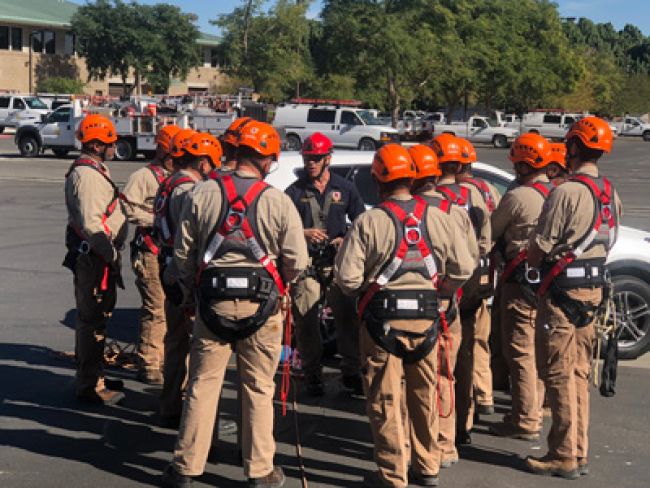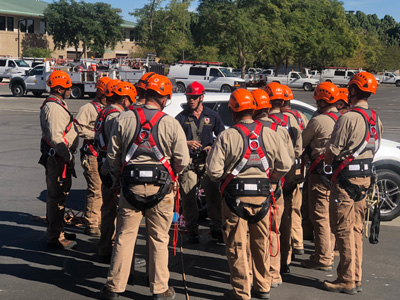
Building and Delivering Effective Safety Courses

At some point, you most likely have heard a co-worker say, “Alright, it’s time for the safety meeting.” Immediately after that, you typically have heard grumbling from other co-workers who were not looking forward to a meeting they believed would be slow and painful. If you’re a safety trainer, you’re probably somewhat familiar with this response and routinely wonder, “What can I do to make my safety training sessions both informative and enjoyable?”
While there is no magical solution or formula, there are a few strategies that trainers can use that will allow trainings to become valuable events that engage trainees and deliver meaningful content.
Establishing Expectations
In the past, I have been fortunate enough to oversee safety for a 700-person facility, teach at all levels of education and work in the entertainment industry. Now, as a lead safety and rescue trainer for Safety One Training, I typically work with linemen, wireless internet crews, railroaders, various government sectors, and other groups seeking to enhance their job-site safety and rescue awareness. My primary student objectives for every training class are simple: identify new work practices or styles, correlate the content to trainees’ personal lives and pass an enjoyable training. In order to achieve these objectives in an eight-hour day, establishing expectations is the first thing that needs to be accomplished.
I establish class expectations at the beginning of the training session, followed by a short discussion of what the trainees expect from me and the curriculum. These conversations typically segue into a group dialogue about what everyone wants to get out of the training. Each individual has specific expectations that can help shape the format of the course.
Individual introductions follow with a focus on pertinent information that will help to structure the class. I ask each student to give me their name, job scope and what they are looking forward to in the training. Remembering and using a trainee’s name throughout the class shows attentiveness to them and respect for their presence. Trainees who feel seen and respected are more likely to return that same respect and less likely to engage the trainer in a game of “Stump the Chump.” The more interactive and specific you can make the first 20 minutes of class, the more likely trainees are to participate.
Four Learning Styles
Perhaps one of the biggest mistakes I have seen in the trainings I have attended is the learning structure of the courses. There is almost nothing that will sink a training faster than a one-way lecture. Instead, when possible, analyze each student to help determine their learning style or styles. There are four primary groups of learning styles, known by the acronym VARK:
- Visual (PowerPoints/videos)
- Auditory (lectures)
- Reading and writing (workbooks/manuals)
- Kinesthetic (hands-on materials)
Through my studies, I have found that most students learn through a mix of styles rather than just one. The majority of people I have taught in the utility sector thrive on kinesthetic learning as the primary method and a mix of visual or auditory learning as the secondary method. For this reason, if you are planning to deliver a lecture to trainees, supplement it by passing around physical materials that relate to the subject matter. If a trainee can hold a specific component in their hand while the trainer is lecturing about it, that trainee is likely to grasp more of the training material. Here’s an example: One difficulty that most train-the-trainer students run into is effectively explaining anchor sling strengths, styles and configurations. Simply passing a sling around the class while walking the trainees through the configurations can help considerably with their learning comprehension, including how quickly they catch on.
If you are curious to find out more about learning styles, it is worth visiting http://vark-learn.com and completing one of their questionnaires. Doing so can help improve your teaching style as well as assist you in formulating new ways of building and presenting training materials.
Building Content
Using the VARK learning styles as a foundation, start to develop your training content based upon strong learning objectives and materials. Every course offered by the company I currently work for includes a PowerPoint presentation, a book, hands-on sections and a test.
What do I mean by “strong learning objectives”? When developing the objectives, avoid using vague words and phrases and opt instead for those that are specific. For example, when creating an objective regarding harness inspections, use “students will describe proper harness fitting and identify critical failure points” instead of “student will know how to inspect a harness.” Try to use active verbs – such as “distinguish” and “identify” – that can be demonstrated.
I recommend using the Bloom’s Taxonomy of Words tower chart (see below) when looking for stronger student objectives. Start with the “Knowledge” thinking skills category at the base of the tower. Moving up the chart builds to the “Evaluation” category and will encourage a higher level of thinking. The taxonomy will help to orient the class and begin identifying ways for the instructor to build the content.

As with learning styles, individuals will respond differently to different educational materials, so it’s important to learn what works best through trial and error. I demonstrated this trial and error when I facilitated a class on how to build and deliver effective safety courses at the spring 2019 iP Utility Safety Conference in Denton, Texas. Using a short PowerPoint presentation, I delivered the same information in three different ways. Slide one was a 160-word paragraph; slide two contained five bullet points; and slide three was a color-sectioned chart. Through a review of the three slides with attendees of that class, we determined what was effective and what wasn’t.
The first slide was a true “death by PowerPoint.” The common trainee response to this type of educational material is “too long, didn’t read.” Excessive text will alienate trainees. Not only that, but if trainees can understand your materials by reading a block of text, why even have a safety meeting or training?
The second slide with five bullet points allowed the group to follow along without losing focus. Bullet points also require the instructor to demonstrate extended subject matter knowledge and present in a way that is fluid.
The final slide featured a chart with colored sections, a simple title and a one-bullet explanation. This type of slide offers students a way to visually interpret the information while also allowing them to follow the lecture without losing focus.
It’s OK for Safety to be Fun
Beyond establishing expectations and delivering quality content, what else can trainers do to engage trainees? They can make the coursework fun and interesting. Telling people that it’s OK for safety to be fun often catches them off guard, but comedy is my favorite tool to use during safety trainings. Obviously, there is a time to focus and be serious, but a dry and lackluster safety course is long and painful to trainees.
Here’s one example of how I try to incorporate fun in a training session: In the train-the-trainer class I deliver, I ask students to think of their favorite comedian – maybe Richard Pryor or Jeff Foxworthy. Then we break down the comedian’s way of interacting with the audience. This exercise might sound a bit out of place for a training, but it helps the trainees think critically about how they can connect with the audience in the training sessions they facilitate. Using humor or other distractions in a class can be helpful in bringing people into the fold on dull subjects, and it can encourage group participation.
Another approach to livening up a class is to liken the training topic to a subject that trainees have a personal interest in. For instance, in the utility sector, building mechanical advantages can be a dense and confusing topic. Sometimes I break up discussion by relating it to hunting – a subject many trainees are interested in. While discussing mechanical advantages, I might say to the class, “If you have a deer that weighs 300 pounds and you need to raise it off your garage floor, you’ll want to make your life as easy as possible, but Home Depot only had so many pulleys. So, what do you do?” From there, I break down how the system will be pulled up or down; where to install blocks, anchors and progress capture; and then how the system also can be used in other settings. Small distractions add relevance to the course and help to refocus the group.
Teaching New Skills
Toward the end of my presentation at the iP Utility Safety Conference in Denton, I had some time left over for general questions. One class attendee asked me, “How do you get people to learn new things when they don’t want to?” It’s a question that most trainers struggle with. For instance, the requirement of wood pole fall restriction devices gets many students who had been accustomed to free-climbing up in arms about being 100% tied off. How do you address this challenge and achieve trainee buy-in? There’s no silver bullet, but a key action is simply to have respect for trainees. At the company I work for, we train on whatever compliant tools the client has or wants to switch to. If I am tasked with changing previous rescue or tool styles, I have roughly four hours of classroom time to address concerns and reassure trainees that change can increase safety and enhance performance. That foundation helps the next four hours of hands-on climbing and rescue. The buy-in from students is easier to obtain after addressing each of their concerns and building a rapport with the group.
The Bottom Line
If you’re a trainer who is looking for ways to bolster trainee interest and engagement, take the time to dig into different learning styles, methods of building content and how you can incorporate fun into your sessions. Educate and respect trainees by delivering material that is both compelling and will help them stay safe on the job.
About the Author: Skylar Ely is a safety and rescue instructor for Safety One Training (www.safetyoneinc.com), where he teaches a rigging class as well as compliance and rescue for tower, wind turbine, confined space, wood pole, and bucket truck/aerial work platform applications. His previous roles have included teaching public school and working in entertainment safety management, stage management, lighting, pyrotechnics and carpentry. Ely has a degree in education and has taught every age group from kindergarteners to adults.

